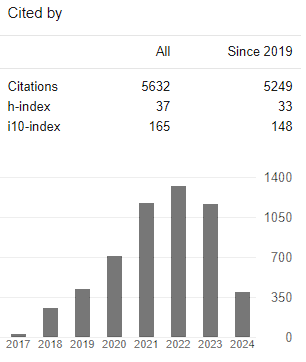The influence of work motivation on employee performance
Case study at PT Pertamina International Refinery RU III Plaju
Keywords:
company, employee performance, human resources, management, work motivationAbstract
This study aims to analyze the effect of work motivation on employee performance at PT Kilang Pertamina Internasional RU III Plaju, the largest oil processing company in Indonesia that faces competitive challenges in the global energy industry. Work motivation is identified as one of the main factors that influence the success of employees in carrying out their duties and responsibilities, and directly impacts the achievement of company goals. This research method uses primary data obtained through questionnaires filled out by 148 company employees, then processed with a Likert scale and statistical analysis. The results showed that work motivation has a significant influence on employee performance, with a correlation coefficient of 0.773. With good motivation, employees tend to be more productive, focused, and committed to work, thus supporting the achievement of organizational goals.
Downloads
References
Apridhani, R. (2023). Plaju Refinery, a Dutch Legacy that Witnesses the History of Pertamina's Founding. Radio Republik Indonesia.
Arshadi, N. (2010). Basic need satisfaction, work motivation, and job performance in an industrial company in Iran. Procedia-Social and Behavioral Sciences, 5, 1267-1272. https://doi.org/10.1016/j.sbspro.2010.07.273
Budur, T., & Poturak, M. (2021). Employee performance and customer loyalty: Mediation effect of customer satisfaction. Middle East Journal of Management, 8(5), 453-474.
Carnevale, J. B., & Hatak, I. (2020). Employee adjustment and well-being in the era of COVID-19: Implications for human resource management. Journal of business research, 116, 183-187. https://doi.org/10.1016/j.jbusres.2020.05.037
Dani, W., Imam, M., & Oktav, B. D. (2022). Human Resource Management to Improve the Capability of the Modern Indonesian Navy in the Industrial Revolution 4.0 1. Journal of Social Sciences, 9(2).
Eliyana, A., & Ma’arif, S. (2019). Job satisfaction and organizational commitment effect in the transformational leadership towards employee performance. European Research on Management and Business Economics, 25(3), 144-150. https://doi.org/10.1016/j.iedeen.2019.05.001
Hayton, J. C. (2005). Promoting corporate entrepreneurship through human resource management practices: A review of empirical research. Human resource management review, 15(1), 21-41. https://doi.org/10.1016/j.hrmr.2005.01.003
Jiang, K., Lepak, D. P., Han, K., Hong, Y., Kim, A., & Winkler, A. L. (2012). Clarifying the construct of human resource systems: Relating human resource management to employee performance. Human resource management review, 22(2), 73-85. https://doi.org/10.1016/j.hrmr.2011.11.005
Jufrizen, J. (2021). Pengaruh fasilitas kerja dan disiplin kerja terhadap kinerja karyawan melalui motivasi kerja. Sains Manajemen: Jurnal Manajemen Unsera, 7(1), 35-54.
Karatepe, O. M. (2013). High-performance work practices and hotel employee performance: The mediation of work engagement. International Journal of Hospitality Management, 32, 132-140. https://doi.org/10.1016/j.ijhm.2012.05.003
Kusumaningrum, H., Alvinas, F. R., Habibi, M. I., & Zhillalurahman, M. F. (2024). Penerapan Staffing untuk Meningkatkan Produktivitas Lembaga Pendidikan. Jurnal Bintang Pendidikan Indonesia, 2(2), 270-289.
McClelland. (2018). Entrepreneur Behavior and Caracteristics of Entrepreneurs. The Achieving Society.
Pertamina. (2024). PT Pertamina International Refinery Unit III. Pertamina International Refinery.
Putri, A. N. H., Wolo, C. W., & Marsofiyat. (2024). The Effect of Job Competence, Job Placement, and Providing Incentives on Employee Work Performance at PT XY. Journal of Rimba: Business Management and Accounting Science Research, 2(1).
Robbins, P. S., & Judge, T. A. (2019). Human Resources Management (16th ed.). Fourth Edition.
Santya, I. M. M. D., & Dewi, I. G. A. M. (2022). Job satisfaction: Its mediating role in the effect of transformational leadership and organizational culture on employee performance. International Research Journal of Management, IT and Social Sciences, 9(4), 569–586. https://doi.org/10.21744/irjmis.v9n4.2118
Sedarmayanti. (2017). Human Resource Management. In Refika Aditama.
Shah, R., & Goldstein, S. M. (2006). Use of structural equation modeling in operations management research: Looking back and forward. Journal of Operations management, 24(2), 148-169. https://doi.org/10.1016/j.jom.2005.05.001
Stoeber, J., Davis, C. R., & Townley, J. (2013). Perfectionism and workaholism in employees: The role of work motivation. Personality and Individual Differences, 55(7), 733-738. https://doi.org/10.1016/j.paid.2013.06.001
Sugiyono. (2019). Quantitative and Qualitative Research Methods and R&D. Alfabeta.
Syafari, M. (2022). Manajemen Sumber Daya Manusia Ramah Lingkungan. Equator Journal of Management and Entrepreneurship (EJME), 10(03), 145-158.
Taghipour, A., & Dejban, R. (2013). Job performance: Mediate mechanism of work motivation. Procedia-Social and Behavioral Sciences, 84, 1601-1605. https://doi.org/10.1016/j.sbspro.2013.06.796
Werner, S. (2002). Recent developments in international management research: A review of 20 top management journals. Journal of management, 28(3), 277-305. https://doi.org/10.1016/S0149-2063(02)00129-0
Wuwungan, M. B., Nelwan, O. S., & Uhing, Y. (2020). Pengaruh kemampuan kerja dan motivasi kerja terhadap kinerja karyawan. Jurnal EMBA: Jurnal Riset Ekonomi, Manajemen, Bisnis dan Akuntansi, 8(1).
Zahara, E. (2018). The Role of Organizational Communication for Organizational Leaders. Warta Dharmawangsa, 56.
Published
How to Cite
Issue
Section
Copyright (c) 2024 International research journal of management, IT and social sciences

This work is licensed under a Creative Commons Attribution-NonCommercial-NoDerivatives 4.0 International License.
Articles published in the International Research Journal of Management, IT and Social sciences (IRJMIS) are available under Creative Commons Attribution Non-Commercial No Derivatives Licence (CC BY-NC-ND 4.0). Authors retain copyright in their work and grant IRJMIS right of first publication under CC BY-NC-ND 4.0. Users have the right to read, download, copy, distribute, print, search, or link to the full texts of articles in this journal, and to use them for any other lawful purpose.
Articles published in IRJMIS can be copied, communicated and shared in their published form for non-commercial purposes provided full attribution is given to the author and the journal. Authors are able to enter into separate, additional contractual arrangements for the non-exclusive distribution of the journal's published version of the work (e.g., post it to an institutional repository or publish it in a book), with an acknowledgment of its initial publication in this journal.
This copyright notice applies to articles published in IRJMIS volumes 7 onwards. Please read about the copyright notices for previous volumes under Journal History.

















